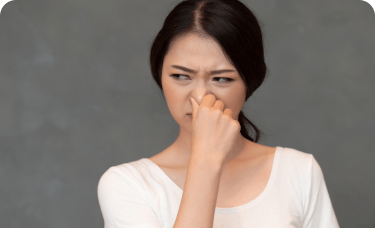A migraine is more than just a bad headache
In the world of head pain, there are headaches—and there are migraines. Affecting 29.5 million Americans every year, migraines rank as the most common type to send sufferers to see their doctor.2 Migraine sufferers can experience pain that is debilitating enough to render them incapable of completing everyday activities.
Although the exact cause of migraine headaches isn't completely understood, medical researchers believe that migraine headaches are caused by altered blood flow and abnormal levels of naturally produced substances in the brain. When certain arteries dilate, blood flow is increased and cause pain producing chemicals to be released. Additionally, the dilation causes an increase in natural substance levels such as prostaglandins and serotonin. This makes the blood vessels lining the brain swell and creates pressure on nearby nerves that send pain signals to the body. The resulting pressure is typically felt as a headache on left side of the head, behind eye or temple region, and can extend to the face, sinus, jaw, or neck.1,2
Learn the different head pain types, so you can choose your best path for treatment.
Migraines vs. tension and cluster headaches
A tension or sinus headache may be less severe (although still painful). They are typically characterized by mild to moderate pain. Cluster headaches affect about one in 1,000 adults and are considered more rare than other types of headaches.3 They are brief, but frequently recurring (up to several times a day) and extremely severe headache.3
Duration of Pain
One way to distinguish the difference between a tough headache and a migraine is by how long it lasts. Cluster headaches tends to occur in “cluster periods” that typically last 6-12 weeks.4 During this period headaches usually occur every day, sometimes several times a day. A cluster headache may only last 15 minutes to up to three hours, around the same time each day, often after you go to bed.4 Tension headaches can last anywhere from 30 minutes to a full week, but the pain is often dull and manageable, if unpleasant.5
Migraine attacks, on the other hand, last roughly four to 72 hours, and even once they have passed, the sufferer may experience after-effects of what is referred to as the post-drome. This includes energy depletion, confusion, dizziness, and mood changes for up to 24 hours following the migraine attack.9
Location, Location, Location
Where it hurts can give you a clue as to which type of head pain you are experiencing. Migraines typically are characterized by throbbing on one side of the head.6 Cluster headaches may be felt in or around one eye (or more generally, one side of the head) and the pain often radiates to other areas of your face, head, neck and shoulders.4 Sinus headaches are concentrated around the bridge of the nose, cheekbones, and forehead. Lastly, tension headaches can be experienced as pain across the entire forehead, which is often described as a band being squeezed around the head.1, 3
Accompanying Symptoms
Migraines may be distinguished from bad headaches by their secondary symptoms, which can include sensitivity to light and noise, nausea or vomiting, dizziness, weakness, and auras. Visual auras include geometric lines, bright light, or shiny waves that a person typically sees in the 5 to 15 minutes before a migraine strikes (but an aura can occur up to 24 hours beforehand). These occur in approximately 15 percent of migraine sufferers.7, 8









